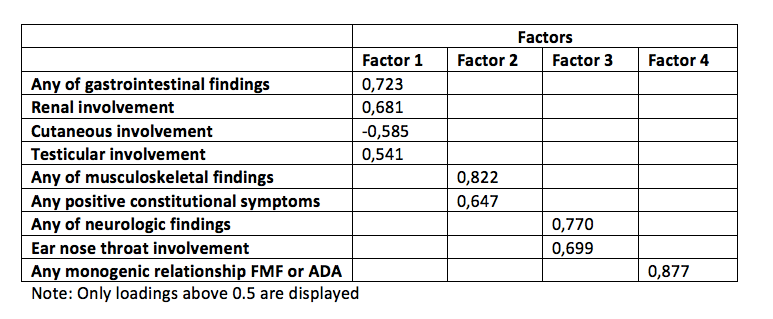Session Information
Session Type: Poster Session (Monday)
Session Time: 9:00AM-11:00AM
Background/Purpose: Polyarteritis nodosa (PAN) is a rare type of the systemic vasculitides with heterogeneous presentations.There is a paucity of information on the current phenotypes, ethnic and geographic differences of PAN. A global PAN study group has been working for clinical subphenotypes and GWAS studies.
Methods: A retrospective survey of databases from centres was done for PAN patients fulfilling the EMEA Vasculitis Classification algorithm. Patients with typical angiographic and/or histopathologic findings consistent with PAN were enrolled. In addition to baseline clinical characteristics, treatment and outcome data was recorded.
Factor analysis was used to analyze target organ associations of these 229 patients. Four factors were identified by factor analysis of variables sex, ethnicity, disease onset age, pediatric-onset, monogenic disease relationship, HBV relationship, any cutaneous features, any musculoskeletal symptoms, any constitutional symptoms, any other involved areas (abdominal, renal, testicular, neurologic, ear nose and throat (ENT), cardiac, pulmonary), positive angiographic findings and relapses.
Results: PAN Cohorts from 5 different countries were investigated in this study. (Japan: n=39, Mexico: n=29, Slovenia: n=14, TUR: n=100, UK: n=47). Totally 229 (M/F: 130/99 and Caucasian 70.3%, Asian 17.0%, and Hispanic 12.7%) patients were included in the study. Four were HBV-related, and 21 of TR patients had a monogenic form of disease (Familial Mediterranean Fever association in 14, deficiency of adenosine deaminase 2-DADA2- in 7).
20.5% of patients were cutaneous-only PAN patients. 45.4% of patients had radiologic, and 69.4% had biopsy-proven PAN. Median age at disease onset was 38.5 (IQR 24.0-57.0) years. During a median 60 (16-130) months follow-up, 23 patients died.
Factor analysis revealed 4 factors that explained 60% of the original information on the matrix as follows: Factor 1,represented the association between any of gastrointestinal findings, renal involvement, and testicular involvement which are negatively associated with any of cutaneous involvement; Factor 2,the association between any of musculoskeletal findings, and any positive constitutional symptoms; Factor 3,any neurologic involvement was associated with ENT involvement, Factor 4,any monogenic relationship FMF or ADA itself. The eigenvalues of the 4 factors were 1.853, 1.297, 1.164, and 1.085, in decreasing order, i.e., the highest contribution to the overall variance in the matrix came from the togetherness of the 3 clinical manifestations that made up Factor 1. Factors, their relative contributions to the total variance and the communalities for each of the variables are shown in Table.
Conclusion: The target organ associations found in this study could support the hypothesis of subphenotypes in PAN. Factor 1-more organ involvement with less cutaneous features seems to be the most severe form. Patients with any monogenic genetic background (FMF or DADA2) have distinct target organ associations. Even though ENT involvement was rare, its association with neurologic involvement might define a different subphenotype- looks like a ANCA negative medium vessel vasculitis.
To cite this abstract in AMA style:
Karadag O, Furuta S, Hocevar A, Gazel U, Hinojosa-Azaola A, Ugurlu S, Gopaluni S, Bolek E, Armagan B, Alibaz-Oner F, Tomšič M, Ayan G, Yazici A, Martin-Nares E, Sánchez-Cubías S, Nedim Tas M, Cefle A, Aksu K, Kono H, Kawakami T, Abe Y, Kaşifoğlu T, Tezcan M, Gercik O, Kilickap S, Direskeneli H, Ozen S, Ertenli A, Jayne D. Target Organ Associations in Polyarteritis Nodosa (PAN): Results of a Worldwide Collaboration Study [abstract]. Arthritis Rheumatol. 2019; 71 (suppl 10). https://acrabstracts.org/abstract/target-organ-associations-in-polyarteritis-nodosa-pan-results-of-a-worldwide-collaboration-study/. Accessed .« Back to 2019 ACR/ARP Annual Meeting
ACR Meeting Abstracts - https://acrabstracts.org/abstract/target-organ-associations-in-polyarteritis-nodosa-pan-results-of-a-worldwide-collaboration-study/

